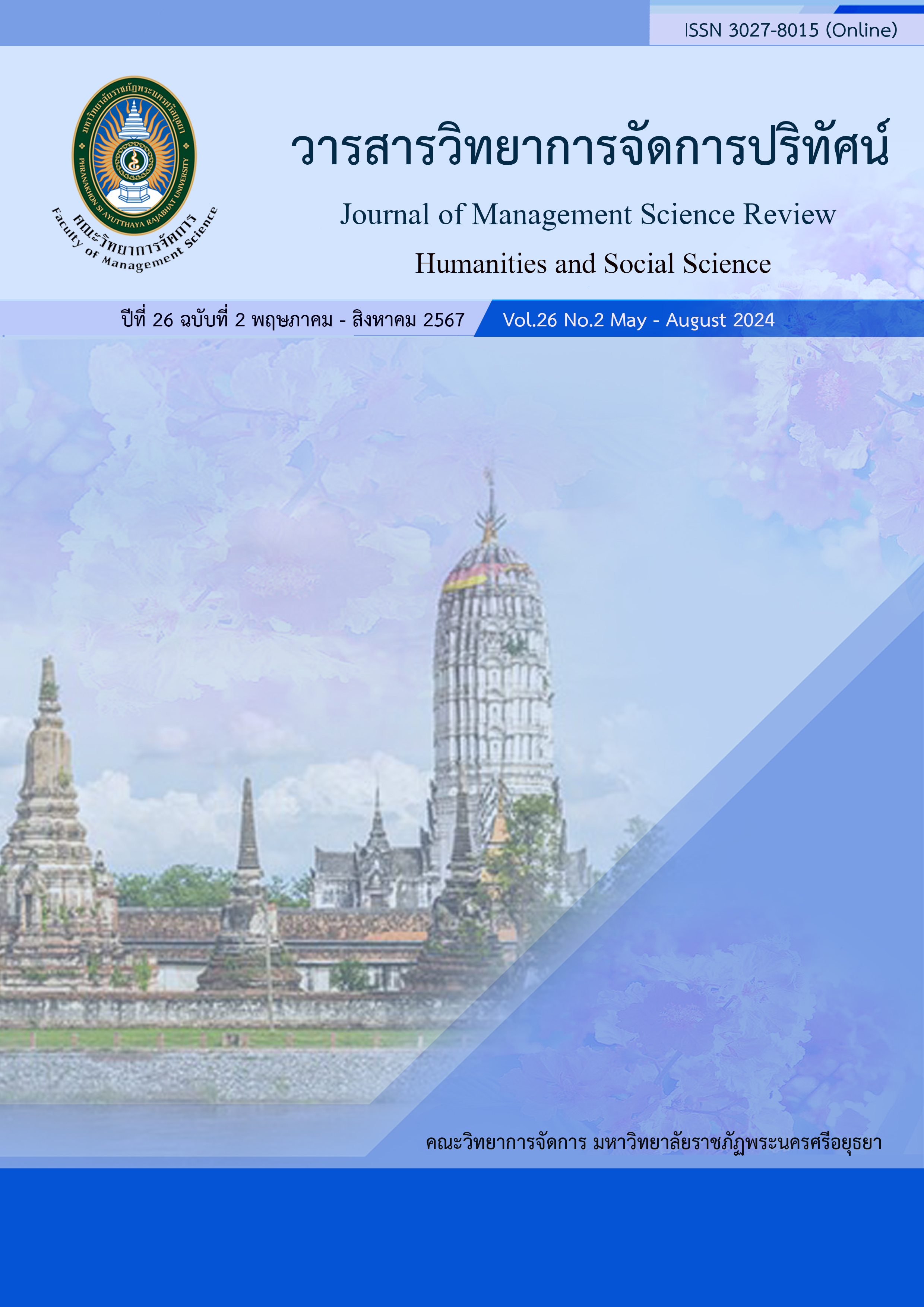The Development of Wellness Tourism Activity Model for Entrepreneur Based on The Concept Of Creative Economy in Loei Province
Keywords:
Development, Wellness Tourism Activity Model, concept of creative economy, Wellness tourism activityAbstract
This research aimed to 1) examine the potential of health tourism entrepreneurs in Loei Province under the creative economy concept, and 2) develop a model of health tourism activities for entrepreneurs based on this concept in Loei Province. The research employed both quantitative and qualitative methods. The research instruments included questionnaires, focus group discussions, and semi-structured interviews. The study population comprised 50 health tourism entrepreneurs, including 20 in the accommodation sector, 18 in the wellness sector (spa, massage, herbal medicine), and 12 in the health food and beverage sector. The data were analyzed using descriptive statistics to calculate frequencies and percentages, and content analysis was applied to qualitative data gathered from in-depth interviews and focus group discussions, particularly focusing on the development of health tourism activity models under the creative economy concept in Loei Province.
The findings revealed that the majority of health tourism entrepreneurs under the creative economy concept in Loei Province were female, aged between 51 and 60 years, with a bachelor's degree, and held positions as owners and partners in their businesses. Most had established their businesses independently, receiving consultation support, and training, and gaining experience and skills through self-learning. The business models predominantly consisted of sole proprietorships across three main sectors. The health tourism activity models based on the creative economy concept included: 1) Accommodation businesses that provided spaces and activities conducive to relaxation and experiential learning, highlighting traditional Thai medicine and the use of natural, chemical-free ingredients in health food preparation (such as elemental-based diets). 2) Wellness businesses (spa, massage, herbal medicine) that incorporated traditional Thai massage techniques, using postures inspired by daily life, such as "Swan-Shin" and "Yok Hiw" movements, along with the use of minerals (such as black stone, Mekong stone) in massages. These massages applied 80%-foot pressure and 20% knee-elbow pressure, with specific massage techniques documented in a massage manual, incorporating the use of traditional Thai fabric during the massage. 3) Health food businesses that offered menus prepared from local ingredients, integrating local wisdom with Thai and Western culinary traditions, resulting in four nutritional dishes: Quiche Shiitake, Shiitake Burger, Stuffed Shiitake, and Avocado Shrimp Cocktail. It was evident that the health tourism activity models developed through this research aligned with the creative economy sectors of food and traditional Thai medicine.
References
กําธร แจ่มจํารัส และญาณิศา เผื่อนเพาะ. (2567). การพัฒนาและยกระดับผลิตภัณฑ์การท่องเที่ยวเชิงสุขภาพเพื่อรองรับนักท่องเที่ยวสูงวัย ในเมืองมรดกโลกสำหรับนักท่องเที่ยวสูงวัย (อำเภอพระนครศรีอยุธยา). วารสารมหาวิทยาลัยคริสเตียน, 30(1), 31 – 47.
กัญญาพัชร์ พัฒนาโภคินสกุล และนิมิต ซุ้นสั้น. (2566). แนวทางการพัฒนาการท่องเที่ยวเชิงสุขภาพแบบสร้างสรรค์: การพัฒนาเมืองรอง จังหวัดระนอง. วารสารรัชต์ภาคย์, 17(50), 328-342.
กระทรวงการท่องเที่ยวและกีฬา. (2563). เเผนพัฒนาการท่องเที่ยวแห่งชาติ ฉบับที่ 2 (พ.ศ. 2560 - 2564). กระทรวงการท่องเที่ยวและกีฬา.
การท่องเที่ยวแห่งประเทศไทย. (2562). รายงานประจำปี 2562.
การท่องเที่ยวแห่งประเทศไทย. (2562). รายงานสรุปแผนปฏิบัติการประจำปี 2562.
จุฑามาศ พีรพัชระ, สมนึก วิสุทธิแพทย์, ธีรวุฒิ บุณยโสภณและทวีศักดิ์ รูปสิงห์. (2561). รูปแบบการพัฒนาศักยภาพผู้ประกอบการธุรกิจร้านอาหาร. วารสารวิชาการนวัตกรรมสื่อสารสังคม, 6(2), 166-176.
ชนิดา ทวีศรี. (2551). การท่องเที่ยวเชิงสุขภาพ. http://www.l3nr.org/posts/166878
ชัยนันต์ ไชยเสน. (2562). การท่องเที่ยวเชิงสุขภาพและนวัตกรรมการพัฒนาอาหารเพื่อสุขภาพ สำหรับโรงแรมในจังหวัดภูเก็ต. Humanities, Social Sciences and arts, 12(5), 262-282.
นฤมล รัตนไพจิตร, ราตรี เขียวรอด และตรีวนันท์ เนื่องอุทัย. (2561). ปัจจัยที่มีอิทธิพลต่อพฤติกรรมการท่องเที่ยวเชิงสุขภาพของผู้สูงอายุจังหวัดนครศรีธรรมราช. มหาวิทยาลัยเทคโนโลยีราชมงคลศรีวิชัย
ปรียานันท์ โพธิ์ศิรวัฒน์, พิชา วิสิทธิ์พานิช และภัทราพร ตึกขาว. (2565). แนวทางการพัฒนาศักยภาพผู้ประกอบการเพื่อสร้างความได้เปรียบทางการแข่งขันของสินค้าหนึ่งตำบลหนึ่งผลิตภัณฑ์ในจังหวัดนครสวรรค์. วารสารรามคำแหง ฉบับบัณฑิตวิทยาลัย, 5(3), 75 – 91.
ปิรันธ์ ชิณโชติ และธีระวัฒน์ จันทึก. (2559).รูปแบบการจัดการการท่องเที่ยวเชิงสร้างสรรค์ของสวนผึ้ง. วารสารสาขามนุษยศาสตร์สังคมศาสตร์และศิลปะ, 9(1), 250-268.
ราณี อิสิชัยกุล. (2560). การท่องเที่ยวเชิงสุขภาพ. http://sms.stou.ac. th/ ?p=2233&lang=en.
สำนักงานคณะกรรมการพัฒนาการเศรษฐกิจและสังคมแห่งชาติ. (2552). เศรษฐกิจสร้างสรรค์ The Creative Economy. รายงานการศึกษาเบื้องต้น.
สำนักงานส่งเสริมเศรษฐกิจสร้างสรรค์. (2565). แผนปฏิบัติการสำนักงานส่งเสริมเศรษฐกิจสร้างสรรค์ (องค์การมหาชน) พ.ศ. 2563 – 2565. กรุงเทพฯ.
อรพิณ สันติธีรากุล. (2543). คู่มือมาตรฐานการพัฒนาผู้ประกอบการ SMEs: การพัฒนาขีดความสามารถผู้ประกอบการ. มหาวิทยาลัยเชียงใหม่.
Global Wellness Institute. (2018). Global Wellness Tourism Economy Executive Summary NOVEMBER2018. Global Wellness Institute.




